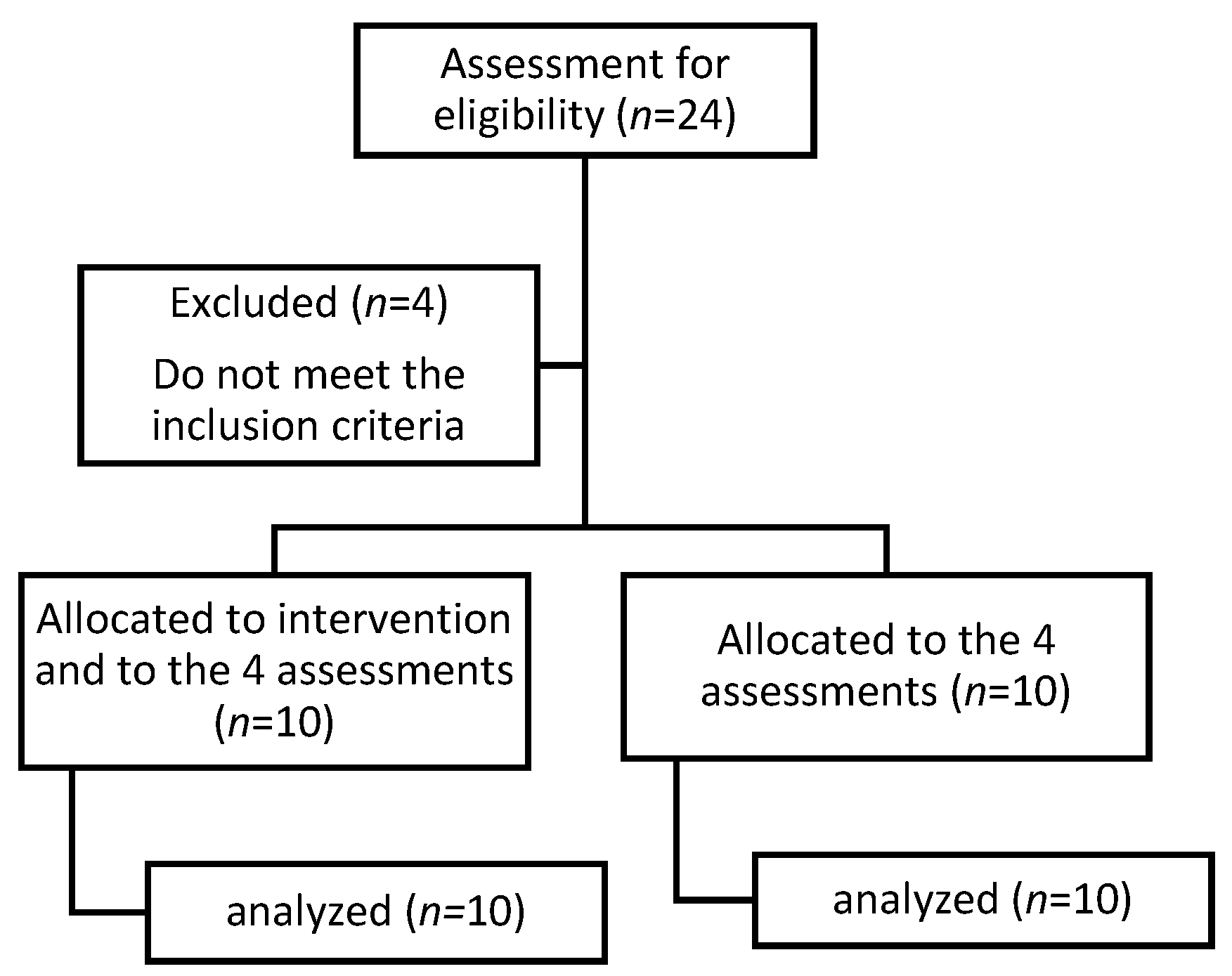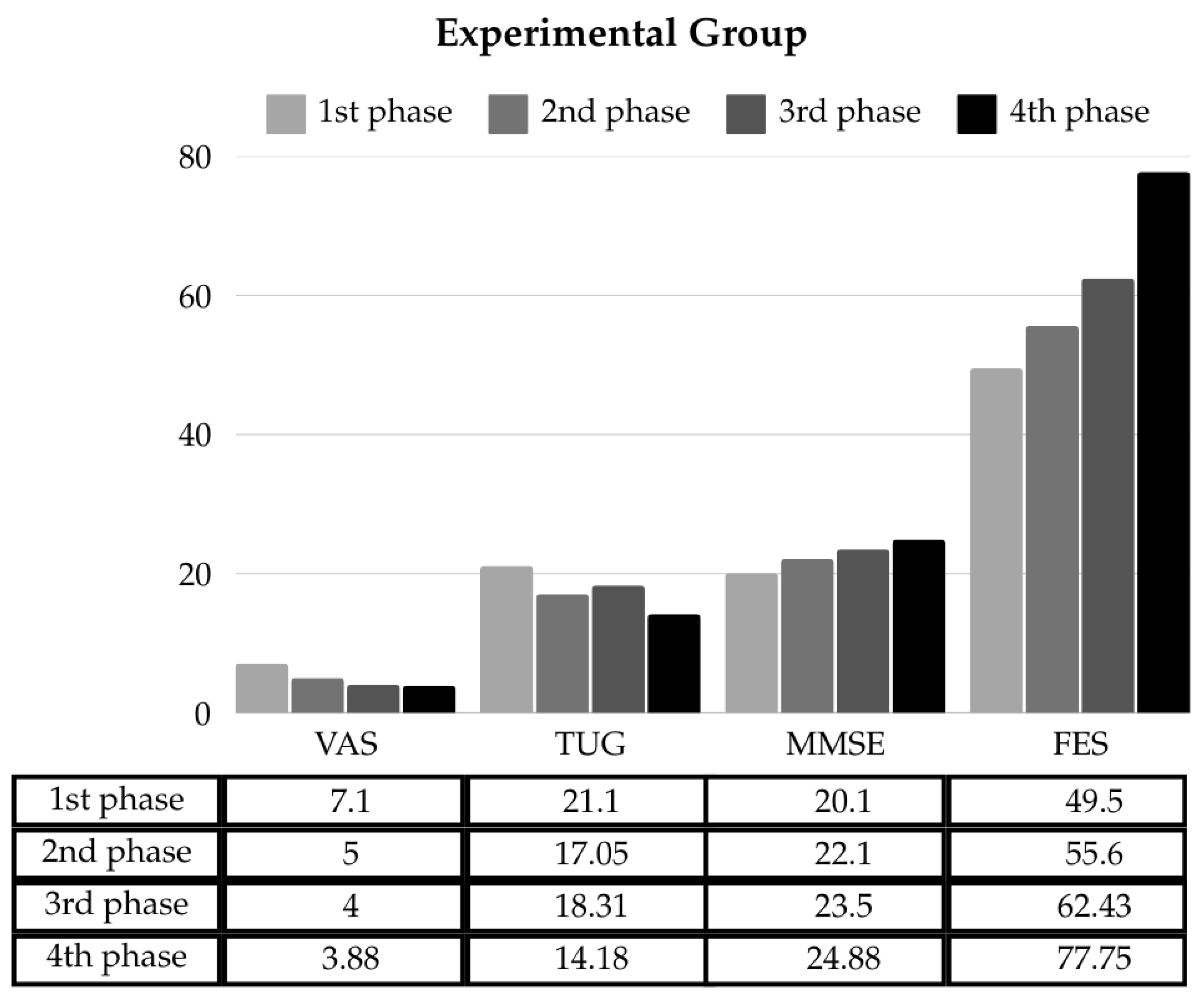Physiotherapy Intervention on Functional Health in Aging on Functional Capacity, Risk of Falls, Cognitive Function, and Back Pain
Abstract
1. Introduction
2. Materials and Methods
2.1. Participants, Therapists, Centers
2.2. Intervention
- Initial questionnaires (T0) and random group allocation.
- Implementation of functional exercises for the EG starting in the second month.
- Reassessment at four-week intervals (T1, T2, and T3) to evaluate the intervention’s effectiveness.
2.3. Data Analysis
3. Results
4. Discussion
Study Limitation
5. Conclusions
Funding
Institutional Review Board Statement
Informed Consent Statement
Data Availability Statement
Acknowledgments
Conflicts of Interest
Abbreviations
| ANZCTR | Australian New Zeeland Clinical Trial |
| VAS | Visual Analog Scale |
| TUG | Timed up and Go |
| FES | Falls Efficacy Scale International |
| MMSE | Mini Mental State Examination |
| CG | control group |
| EG | experimental group |
References
- Christensen, U.; Støvring, N.; Schultz-Larsen, K.; Schroll, M.; Avlund, K. Functional ability at age 75: Is there an impact of physical inactivity from middle age to early old age? Scand. J. Med. Sci. Sports 2006, 16, 245–251. [Google Scholar] [CrossRef] [PubMed]
- Sherrington, C.; Tiedemann, A. Physiotherapy in the prevention of falls in older people. J. Physiother. 2015, 61, 54–60. [Google Scholar] [CrossRef]
- DGS M da S. Estratégia Nacional para a Qualidade na Saúde. DGS. 2015. Available online: https://diariodarepublica.pt/dr/detalhe/despacho/5613-2015-67324029 (accessed on 26 December 2024).
- WHO. Physical Activity and Older Adults; WHO: Geneva, Switzerland, 2011; pp. 1–58. [Google Scholar]
- Nunes, A.M. A Recuperação Do Serviço Nacional De Saúde Português: Novas Perspectivas Para A Política De Saúde. Rev. Gestão Sist. Saúde 2018, 7, 16–28. [Google Scholar] [CrossRef]
- Desouzart, G.; Matos, R.; Melo, F.; Filgueiras, E. Effects of sleeping position on back pain in physically active seniors: A controlled pilot study. Work 2016, 53, 235–240. [Google Scholar] [CrossRef] [PubMed]
- Taylor, A.H.; Cable, N.T.; Faulkner, G.; Hillsdon, M.; Narici, M.; Van Der Bij, A.K. Physical activity and older adults: A review of health benefits and the effectiveness of interventions. J. Sports Sci. 2004, 22, 703–725. [Google Scholar] [CrossRef]
- Tribess, S.; Virtuoso, J.S., Jr. Prescription of physical exercises for elderly. Rev. Saude Com 2005, 1, 163–172. [Google Scholar]
- Maciel, M.G. Atividade física e funcionalidade do idoso. Mot. Rev. Educ. Física 2010, 16, 1024–1032. [Google Scholar] [CrossRef]
- American College of Sports Medicine. ACSM’s Exercise Testing and Prescription; Lippincott Williams & Wilkins: Philadelphia, PA, USA, 2017. [Google Scholar]
- Theou, O.; Stathokostas, L.; Roland, K.P.; Jakobi, J.M.; Patterson, C.; Vandervoort, A.A.; Jones, G.R. The effectiveness of exercise interventions for the management of frailty: A systematic review. J. Aging Res. 2011, 2011, 569194. [Google Scholar] [CrossRef]
- Trudelle-Jackson, E.; Jackson, A.W. Do older adults who meet 2008 Physical Activity Guidelines have better physical performance than those who do not meet? J. Geriatr. Phys. Ther. 2018, 41, 180–185. [Google Scholar] [CrossRef]
- Shubert, T.E. Evidence-based exercise prescription for balance and falls prevention: A current review of the literature. J. Geriatr. Phys. Ther. 2011, 34, 100–108. [Google Scholar] [CrossRef]
- Serra-Rexach, J.A.; Bustamante-Ara, N.; Hierro, V.M.; González Gil, P.; Sanz Ibáñez, M.J.; Blanco Sanz, N.; Ortega Santamaría, V.; Gutiérrez Sanz, N.; Marín Prada, A.B.; Gallardo, C.; et al. Short-term, light-to moderate-intensity exercise training improves leg muscle strength in the oldest old: A randomized controlled trial. J. Am. Geriatr. Soc. 2011, 59, 594–602. [Google Scholar] [CrossRef]
- Tsai, J.C.; Chan, P.; Wang, C.-H.; Jeng, C.; Hsieh, M.H.; Kao, P.F.; Chen, Y.J.; Liu, J.C. The effects of exercise training on walking function and perception of health status in elderly patients with peripheral arterial occlusive disease. J. Intern. Med. 2002, 252, 448–455. [Google Scholar] [CrossRef] [PubMed]
- Windle, G.; Hughes, D.; Linck, P.; Russell, I.; Woods, B. Is exercise effective in promoting mental well-being in older age? A systematic review. Aging Ment. Health 2010, 14, 652–669. [Google Scholar] [CrossRef] [PubMed]
- Piovesan, A.C.; Pivetta, H.M.F.; Peixoto., J.M.d.B. Fatores que predispõem a quedas em idosos residentes na região oeste de Santa Maria, RS. Rev. Bras. Geriatr. E Gerontol. 2011, 14, 75–83. [Google Scholar] [CrossRef]
- WHO. A Policy Framework. Em: Active Aging; World Health Organization: Geneva, Switzerland, 2002. [Google Scholar]
- Duarte de Queiroz Brito, T.; de Oliveira, A.R.; do Carmo Eulálio, M. Disability and Aging: Study of Social Representations of the Elderly from Physical Therapy Rehabilitation. Av. Psicol. Latinoam. 2015, 33, 121–133. [Google Scholar]
- Gschwind, Y.J.; Kressig, R.W.; Lacroix, A.; Muehlbauer, T.; Pfenninger, B.; Granacher, U. A best practice fall prevention exercise program to improve balance, strength/power, and psychosocial health in older adults: Study protocol for a randomized controlled trial. BMC Geriatr. 2013, 13, 105. [Google Scholar] [CrossRef] [PubMed]
- Dutra, M.O.M.; Coura, A.S.; de França, I.S.X.; Enders, B.C.; Rocha, M.A. Sociodemographic factors and functional capacity of elderly affected by stroke. Rev. Bras. Epidemiol. 2017, 20, 124–135. [Google Scholar] [CrossRef]
- Costa, L.O.P.; Maher, C.G.; Latimer, J.; Hodges, P.W.; Herbert, R.D.; Refshauge, K.M.; McAuley, J.H.; Jennings, M.D. Motor control exercise for chronic low back pain: A randomized placebo-controlled trial. Phys. Ther. 2009, 89, 1275–1286. [Google Scholar] [CrossRef]
- Rockwood, K. What would make a definition of frailty successful? Age Ageing 2005, 34, 432–434. [Google Scholar] [CrossRef]
- Nakagawa, K.; Inomata, N.; Nakazawa, R.; Sakamoto, M. The effect of a health promotion program consisting of easy and simple exercises for community living elderly people. J. Phys. Ther. Sci. 2007, 19, 235–242. [Google Scholar] [CrossRef][Green Version]
- Nunciato, A.C.; Pereira, B.C.; Borghi-Silva, A. Métodos de avaliação da capacidade física e qualidade de vida em idosos: Revisão de literatura. Saúde Rev. 2012, 12, 41–48. [Google Scholar] [CrossRef]
- Camargos, F.F.O.; Dias, R.C.; Dias, J.; Freire, M.T.F. Cross-cultural adaptation and evaluation of the psychometric properties of the Falls Efficacy Scale-International Among Elderly Brazilians (FES-I-BRAZIL). Braz. J. Phys Ther. 2010, 14, 237–243. [Google Scholar] [CrossRef]
- Santana, I.; Duro, D.; Lemos, R.; Costa, V.; Pereira, M.; Simões, M.R.; Freitas, S. Mini-Mental State Examination: Avaliação dos Novos Dados Normativos no Rastreio e Diagnóstico do Défice Cognitivo. Acta Med. Port. 2016, 29, 240–248. Available online: https://www.actamedicaportuguesa.com/revista/index.php/amp/article/view/6889 (accessed on 26 December 2024). [CrossRef] [PubMed]
- Maroco, J. Análise Estatística com o SPSS Statistics, 7th ed.; ReportNumber: Lisboa, Portugal, 2018. [Google Scholar]
- de Labra, C.; Guimaraes-Pinheiro, C.; Maseda, A.; Lorenzo, T.; Millán-Calenti, J.C. Effects of physical exercise interventions in frail older adults: A systematic review of randomized controlled trials. BMC Geriatr. 2015, 15, 154. [Google Scholar] [CrossRef] [PubMed]
- Petry, N.M.; Andrade, L.F.; Barry, D.; Byrne, S. A randomized study of reinforcing ambulatory exercise in older adults. Psychol. Aging 2013, 28, 1164. [Google Scholar] [CrossRef] [PubMed]
- Castro, D.C.; Nunes, D.P.; Pagotto, V.; Pereira, L.V.; Bachion, M.M.; Nakatani, A.Y.K. Incapacidade funcional para atividades básicas de vida diária de idosos: Estudo populacional/Functional disability for basic activities of daily lives of the elderly: A population study. Ciência Cuid. E Saúde 2016, 15, 109–117. [Google Scholar] [CrossRef]
- Siegrist, M.; Freiberger, E.; Geilhof, B.; Salb, J.; Hentschke, C.; Landendoerfer, P.; Linde, K.; Halle, M.; Blank, W.A. Fall prevention in a primary care setting: The effects of a targeted complex exercise intervention in a cluster randomized trial. Dtsch. Ärzteblatt Int. 2016, 113, 365. [Google Scholar]


| First Phase | Second Phase | Third Phase | Fourth Phase | |
|---|---|---|---|---|
| Experimental group | 7.10 ± 3.695 | 5.00 ± 3.091 (p = 0.051) | 4.00 ± 1.944 (p = 0.022) | 3.88 ± 2.232 (p = 0.032) |
| Control group | 4.30 ± 3.234 | 3.20 ± 2.530 (p = 0.149) | 2.70 ± 2.11 (p = 0.217) | 3.70 ± 1.889 (p = 0.529) |
| First Phase | Second Phase | Third Phase | Fourth Phase | |
|---|---|---|---|---|
| Experimental group | 21.10 ± 10.064 | 17.05 ± 6.482 (p = 0.174) | 18.31 ± 9.143 (p = 0.326) | 14.18 ± 4.797 (p = 0.016) |
| Control group | 18.38 ± 4.492 | 16.94 ± 3.434 (p = 0.496) | 17.07 ± 4.144 (p = 0.597) | 17.33 ± 6.655 (p = 0.406) |
| First Phase | Second Phase | Third Phase | Fourth Phase | |
|---|---|---|---|---|
| Experimental group | 20.10 ± 4.149 | 22.10 ± 4.306 (p = 0.223) | 23.50 ± 3.837 (p = 0.057) | 24.88 ± 3.227 (p = 0.023) |
| Control group | 21.90 ± 3.542 | 23.40 ± 4.351 (p = 0.361) | 23.20 ± 4.442 (p = 0.569) | 21.70 ± 3.802 (p = 0.820) |
| First Phase | Second Phase | Third Phase | Fourth Phase | |
|---|---|---|---|---|
| Experimental group | 49.50 ± 18.934 | 55.60 ± 19.357 (p = 0.342) | 62.43 ± 19.156 (p = 0.158) | 77.75 ± 14.964 (p = 0.013) |
| Control group | 67.20 ± 18.902 | 70.80 ± 23.593 (p = 0.579) | 72.50 ± 25.176 (p = 0.850) | 73.90 ± 27.851 (p = 0.705) |
Disclaimer/Publisher’s Note: The statements, opinions and data contained in all publications are solely those of the individual author(s) and contributor(s) and not of MDPI and/or the editor(s). MDPI and/or the editor(s) disclaim responsibility for any injury to people or property resulting from any ideas, methods, instructions or products referred to in the content. |
© 2025 by the author. Licensee MDPI, Basel, Switzerland. This article is an open access article distributed under the terms and conditions of the Creative Commons Attribution (CC BY) license (https://creativecommons.org/licenses/by/4.0/).
Share and Cite
Desouzart, G. Physiotherapy Intervention on Functional Health in Aging on Functional Capacity, Risk of Falls, Cognitive Function, and Back Pain. Osteology 2025, 5, 10. https://doi.org/10.3390/osteology5010010
Desouzart G. Physiotherapy Intervention on Functional Health in Aging on Functional Capacity, Risk of Falls, Cognitive Function, and Back Pain. Osteology. 2025; 5(1):10. https://doi.org/10.3390/osteology5010010
Chicago/Turabian StyleDesouzart, Gustavo. 2025. "Physiotherapy Intervention on Functional Health in Aging on Functional Capacity, Risk of Falls, Cognitive Function, and Back Pain" Osteology 5, no. 1: 10. https://doi.org/10.3390/osteology5010010
APA StyleDesouzart, G. (2025). Physiotherapy Intervention on Functional Health in Aging on Functional Capacity, Risk of Falls, Cognitive Function, and Back Pain. Osteology, 5(1), 10. https://doi.org/10.3390/osteology5010010






